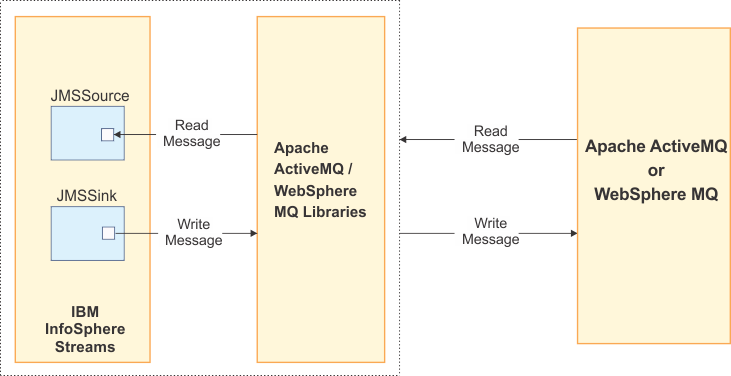IBMStreams com.ibm.streamsx.messaging Toolkit > com.ibm.streamsx.messaging 5.4.3
General Information
The Messaging toolkit project is an open source IBM Streams toolkit project. It is focused on the development of operators and functions that help you use IBM Streams to interact with messaging systems such as Kafka, JMS, XMS, and MQTT.
The operators provide the ability for IBM Streams applications to send and receive data from a queue or topic that is posted on Kafka, WebSphere MQ, Apache ActiveMQ or MQ Telemetry Transport (MQTT) server.
In particular, the XMSSource and XMSSink operators in the Messaging Toolkit use the standard XMS architecture and APIs to read and write data from WebSphere MQ v7.5 and v8.0.
The JMSource and JMSSink operators use the standard JMS architecture and JMS 1.1 APIs to read and write data from WebSphere MQ v7.5, v8.0 and Apache ActiveMQ v5.7 and up.
The MQTTSource and MQTTSink operators use the MQTT architecture and APIs to read and write to MQTT providers. The operators support IBM MessageSight v1.1 and v1.2.
The KafkaProducer and KafkaConsumer operators support Kafka v0.10.0.0 brokers. For 0.9 brokers, you make rebuild the toolkit for Kafka 0.9 by running the following commands: ant clean; ant kafka-0.9 For older versions of Kafka brokers, you must use older versions of this toolkit.
Restriction: The XMSSource and XMSSink operators in the Messaging Toolkit are supported on x86_64 systems.
Restriction: The XMSSource and XMSSink operators in the Messaging Toolkit are not supported on RHEL 7 platforms.
The following figure shows how the XMSSink and XMSSource operators in the Messaging Toolkit use standard XMS architecture and APIs. 
- The CreateProducer API creates a message producer to send messages to the specified destination.
- The CreateConsumer API creates a message consumer for the specified destination.
- The CreateConnection API creates a connection that uses a specified user identity. The specified user identifier and password are used to authenticate the application.
The following figure shows how the JMSSource and JMSSink operators in the Messaging Toolkit use standard JMS architecture and APIs. 
The Messaging Toolkit operators (JMS, XMS and MQTT) must be configured to connect to messaging systems. This configuration information is specified in an XML document, called a connection specifications document. The connection specifications document is similar to but separate from the document that is used by the Database Toolkit.
- Version
- 5.4.3
- Required Product Version
- 4.2.0.0
- Author
- IBMStreams Open Source Community at GitHub - https://github.com/IBMStreams/streamsx.messaging
Indexes
Namespaces
- com.ibm.streamsx.messaging.jms
- Conversions between JMS messages and tuples in IBM InfoSphere Streams
- com.ibm.streamsx.messaging.kafka
- Kafka Properties
- Operators
- com.ibm.streamsx.messaging.mqtt
- Deprecation of MQTT functions
- Operators
- com.ibm.streamsx.messaging.rabbitmq
- Operators
- com.ibm.streamsx.messaging.xms
- Conversions between XMS messages and tuples in IBM InfoSphere Streams